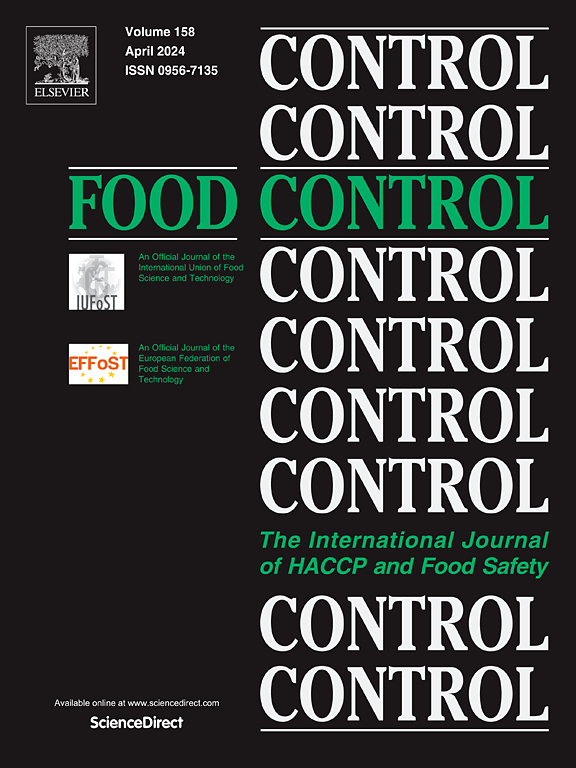A volatilomic approach using ion mobility and mass spectrometry combined with multivariate chemometrics for the assessment of lemon juice quality
IF 5.6
1区 农林科学
Q1 FOOD SCIENCE & TECHNOLOGY
引用次数: 0
Abstract
Lemon (Citrus limon (L.) Burm.) is a citrus fruit known for its high nutritional value and potent antioxidant activity. Lemon juice, obtained by squeezing the fruit, is widely used in the kitchen for its acidic taste to flavour dishes and drinks. It has also been attributed with various medicinal properties to treat conditions such as sore throat, fever, rheumatism and hypertension. Ensuring the quality and safety of lemon juice, as well as its geographical origin, is not easy due to the scarcity of analytical methods available for this purpose, which makes it difficult to detect adulterations. To meet this challenge of testing the authenticity and safety of lemon juice, multiple physicochemical parameters need to be evaluated, which is expensive and time-consuming, so it is of great interest to develop an alternative simple method. In this research, two alternative analytical methods were developed and optimized for the analysis of lemon juice samples based on headspace gas chromatography coupled to both mass spectrometry (HS-GC-MS) or ion mobility spectrometry (HS-GC-IMS). These new methods were compared with the method currently used in the food industry for quality control of juices, which is Fourier transform near infrared spectroscopy (FT-NIR). A total of 159 samples belonging to different lemon varieties were analysed by measuring the physicochemical parameters, FT-NIR spectra and fingerprinting of the juice samples based on the total volatile compounds profile by GC-MS and GC-IMS. Partial least squares (PLS) regression models were then constructed and all models were validated by paired tests with the values measured by the reference chemical methods. The models developed confirm that both HS-GC-MS and HS-GC-IMS methods are viable alternatives for predicting physicochemical parameters and ensuring lemon juice quality. Finally, the data were used to build chemometric models using orthogonal partial least squares discriminant analysis (OPLS-DA) to distinguish lemon juices according to the lemon variety used in their manufacture. Very promising models were obtained with the HS-GC-MS and HS-GC-IMS data, suggesting the potential use of the volatile profile for lemon variety confirmation. Consequently, fingerprinting represents an alternative proposal to the conventional method applied in the food industry based on the use of chemical reference parameters or the use of the NIR technique.
利用离子迁移率和质谱法结合多元化学计量学的挥发性方法评估柠檬汁的质量
柠檬(Citrus limon (L.) Burm.)是一种柑橘类水果,以营养价值高、抗氧化能力强而著称。通过挤压果实获得的柠檬汁因其酸味而被广泛用于厨房,为菜肴和饮料调味。它还具有多种药用功效,可治疗喉咙痛、发烧、风湿病和高血压等疾病。要确保柠檬汁的质量和安全及其原产地并不容易,因为缺乏相关的分析方法,很难检测出掺假行为。为了应对检测柠檬汁真伪和安全性的挑战,需要对多种理化参数进行评估,这既昂贵又耗时,因此开发一种替代性的简单方法非常有意义。本研究开发并优化了两种替代分析方法,用于分析柠檬汁样品,这两种方法基于顶空气相色谱联用质谱法(HS-GC-MS)或离子迁移谱法(HS-GC-IMS)。这些新方法与食品行业目前用于果汁质量控制的傅立叶变换近红外光谱法(FT-NIR)进行了比较。通过测量理化参数、傅立叶变换近红外光谱仪光谱和基于 GC-MS 和 GC-IMS 总挥发性化合物特征的果汁样品指纹图谱,共分析了 159 个属于不同柠檬品种的样品。然后构建了偏最小二乘法(PLS)回归模型,并通过与参考化学方法测得的数值进行配对测试,对所有模型进行了验证。建立的模型证实,HS-GC-MS 和 HS-GC-IMS 方法都是预测理化参数和确保柠檬汁质量的可行替代方法。最后,利用这些数据建立了化学计量模型,并使用正交偏最小二乘判别分析 (OPLS-DA) 根据生产中使用的柠檬品种来区分柠檬汁。利用 HS-GC-MS 和 HS-GC-IMS 数据建立的模型非常有前景,这表明挥发物特征曲线有可能用于柠檬品种的确认。因此,指纹图谱是食品工业中基于化学参考参数或使用近红外技术的传统方法的替代方案。
本文章由计算机程序翻译,如有差异,请以英文原文为准。
求助全文
约1分钟内获得全文
求助全文
来源期刊

Food Control
工程技术-食品科技
CiteScore
12.20
自引率
6.70%
发文量
758
审稿时长
33 days
期刊介绍:
Food Control is an international journal that provides essential information for those involved in food safety and process control.
Food Control covers the below areas that relate to food process control or to food safety of human foods:
• Microbial food safety and antimicrobial systems
• Mycotoxins
• Hazard analysis, HACCP and food safety objectives
• Risk assessment, including microbial and chemical hazards
• Quality assurance
• Good manufacturing practices
• Food process systems design and control
• Food Packaging technology and materials in contact with foods
• Rapid methods of analysis and detection, including sensor technology
• Codes of practice, legislation and international harmonization
• Consumer issues
• Education, training and research needs.
The scope of Food Control is comprehensive and includes original research papers, authoritative reviews, short communications, comment articles that report on new developments in food control, and position papers.
 求助内容:
求助内容: 应助结果提醒方式:
应助结果提醒方式:


